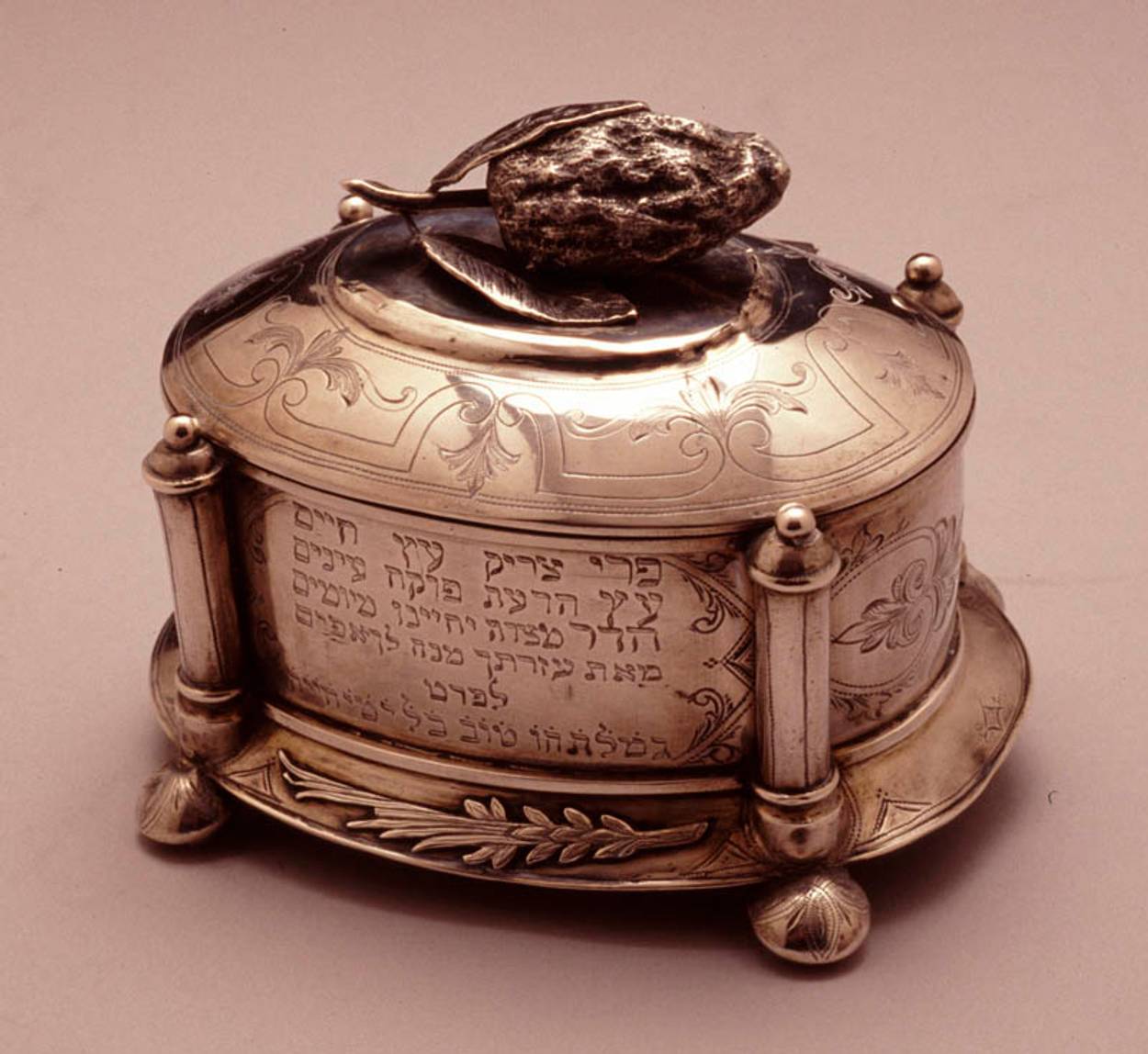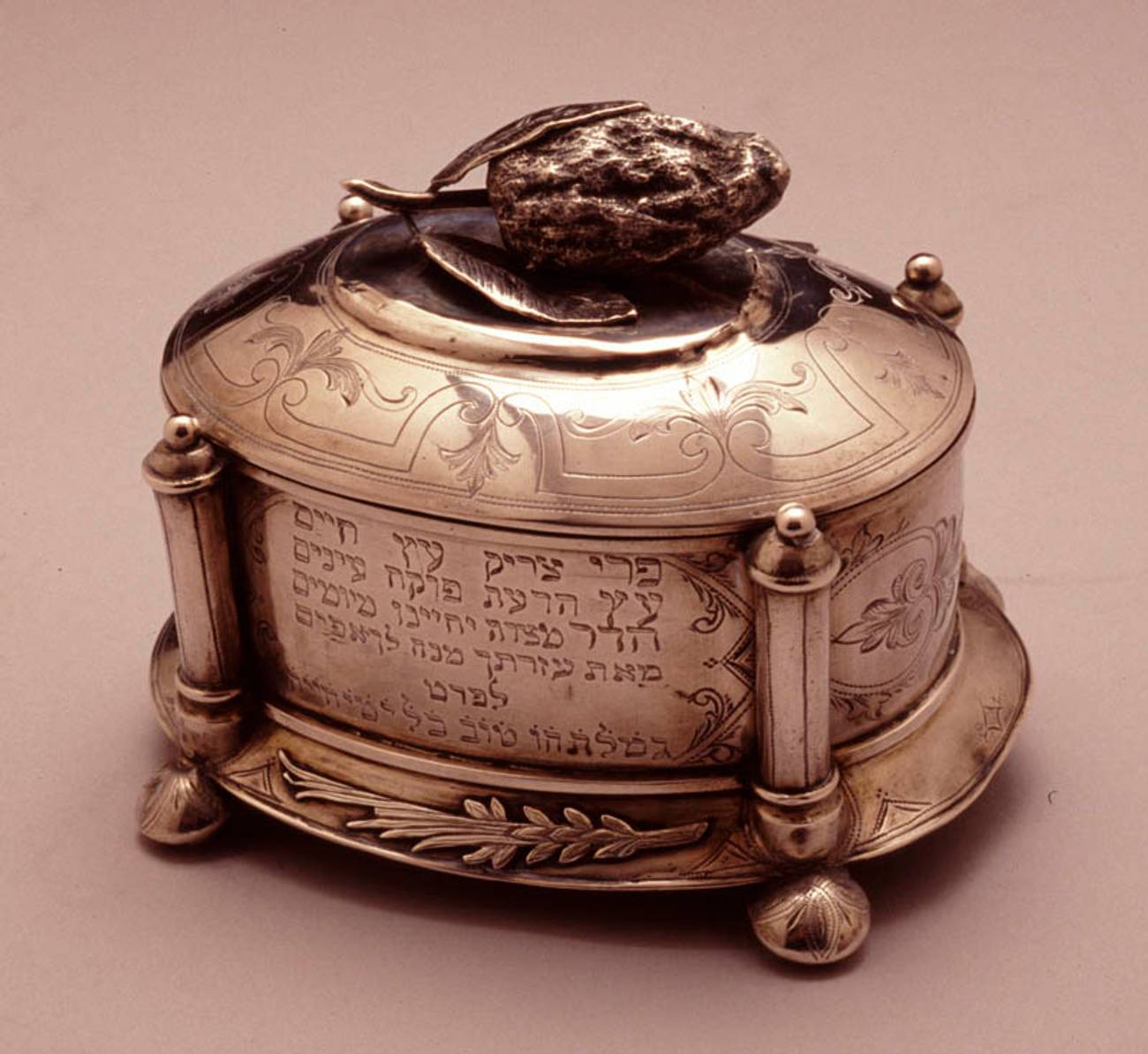The Etrog’s Storied Past
A new collection looks at the history of the fruit that Sukkot made famous




K’tonton, that stalwart sprite of American Jewish children’s literature, got into all sorts of scrapes by swinging on a lulav. He also liked to play hide-and-seek, enclosing his tiny self in a box—not any box, mind you, but one that contained an etrog, or, as it’s known in botanical circles, a citron. Snuggling alongside the fruit, which had traveled all the way from the Holy Land to the United States, K’tonton rested his body on a bed made of flax, protected on all sides from the elements.
Neither K’tonton, nor his creator, Sadie Rose Weilerstein, said anything about the kind of container that housed the pint-size scamp; the book’s illustrator, Jeannette Borkowitz, didn’t draw one, either, leaving its features to our imagination. I wonder if that collective omission was due to the fact that by the time The Adventures of K’tonton saw the light of day, during the 1930s, many varieties of etrog boxes had become available.
Some were made of olive wood, others of silver, and still others were fashioned out of sturdy paper stock. They might echo the shape of the etrog, or assume a rectangular form, be sleek and modern in appearance, or hark back to an imagined biblical model. Some receptacles hailed from Jerusalem, where craftsmen associated with the Bezalel School of Arts and Crafts left their mark, while others were the handiwork of skilled German Jewish silversmiths. And some, like the paper containers with which American Jews are most familiar—the ones with muddy-colored illustrations of an etrog and a lulav or of Jerusalem on each of their four sides—represented a canny mixture of consumerism and constancy, a stand-in for the real thing.
Fascinating in their own right, there’s even more to the etrog than meets the eye. Its receptacles are only the tip of the story, which encompasses horticulture, as you might expect, as well as weaponry, childbirth, trust, and ritual innovation, which you might not. This piece of fruit has a history, a claim that might seem so outlandish as to give rise to concern that, in advancing it, I’ve been tippling too much citron liqueur.
I stand by that claim, as does the talented trio of editors—Sharon Liberman Mintz, Joshua Teplitsky, and Warren Klein—responsible for Be Fruitful!: The Etrog in Jewish Art, Culture, and History, a wondrous new book from Mineged Press that takes stock of this most versatile of Mother Nature’s gifts over time, place, and discipline. An exhibition is also in the works. As its name makes clear, this volume is all about the etrog. It’s also a stunning demonstration of what happens when people put their heads together, share their gifts, and think collaboratively: a testament to the fruitfulness of intellectual exchange.
Each of the editors brought a singular perspective to bear. Klein, curator of New York’s Herbert & Eileen Bernard Museum, applied his widespread knowledge of and expertise in Jewish visual and material culture to the proceedings. Liberman Mintz, curator of Jewish art at the Jewish Theological Seminary and senior consultant of Judaica at Sotheby’s New York, had long been interested in German Jewish silversmiths of the early 20th century and the ways in which they married modern design to age-old Jewish ritual objects such as the etrog container. Teplitsky, a much laureled historian of the early modern experience, who holds the Joseph Meyerhoff Chair of Modern Jewish History at the University of Pennsylvania, was drawn to the etrog after he happened upon a series of documents in a Prague archive that had to do with a Jewish communal figure known as the esroger, piquing his curiosity to know more.
The three of them came up with the idea of a book that would, through words and images, reflect on the presence of the etrog and its hold on the Jewish imagination over time. They then set about corralling an interdisciplinary group of scholars from Europe, Israel, and the United States who also happened to be at various points in their career—some were senior scholars, others just starting out—to make good on their vision. (Full disclosure: I’m among them.)
In showcasing this close kin of the lemon, the project’s guiding lights knew just enough to argue that the etrog might serve effectively as a “prism,” through which multiple aspects of Jewish history and culture might be illuminated. Little did they know what would come across the transom. It was one thing, after all, to make the case that the etrog be systematically explored in much the same way that cod, say, or sugar or salt had received their due; it was quite another to discover how far the book’s contributors could run with their subject.
“Who would have imagined that a whole book could be written about a relatively small citrus fruit of little culinary appeal, a fruit that is held in hand for a few days a year and then discarded?” its editors write quizzically in its introduction, before demonstrating that, yes, one could do just that. Alighting in ancient Palestine and 17th-century Frankfurt, on the island of Corfu and the isle of Manhattan, the volume’s contents range over time as well as space, situating the etrog in a variety of temporal moments that range from antiquity to modernity and in settings that run the gamut from houses of worship to commercial fairs.
Readers will learn that the etrog was used as a weapon with which to pelt one’s enemies, as an amulet to soften the pains of childbirth, and as the source of political clout and economic mobility. The stuff of artistic and visual expression—all those etrog boxes!—as well as scientific exchange, the fruit appears on the face of coins in the ancient Near East; on the walls of a first-century BCE catacomb in Rome; on carvings of Byzantine-era synagogues throughout the diaspora; and in 15th-century Italian manuscripts where tiny figures hold an etrog in their left hand and a lulav in their right.
The ritual fruit has also been the stuff of heated rabbinic disputes, international boycotts, far-flung global trade, pageantry, song, and literature, where it takes center stage in Agnon’s evocative short story “The Etrog,” with which, appropriately enough, this volume closes.
I’m sure my brief summary has left out something, but then I think you get the point: The Zelig-like etrog has been everywhere.
Jenna Weissman Joselit, the Charles E. Smith Professor of Judaic Studies & Professor of History at the George Washington University, is currently at work on a biography of Mordecai M. Kaplan.